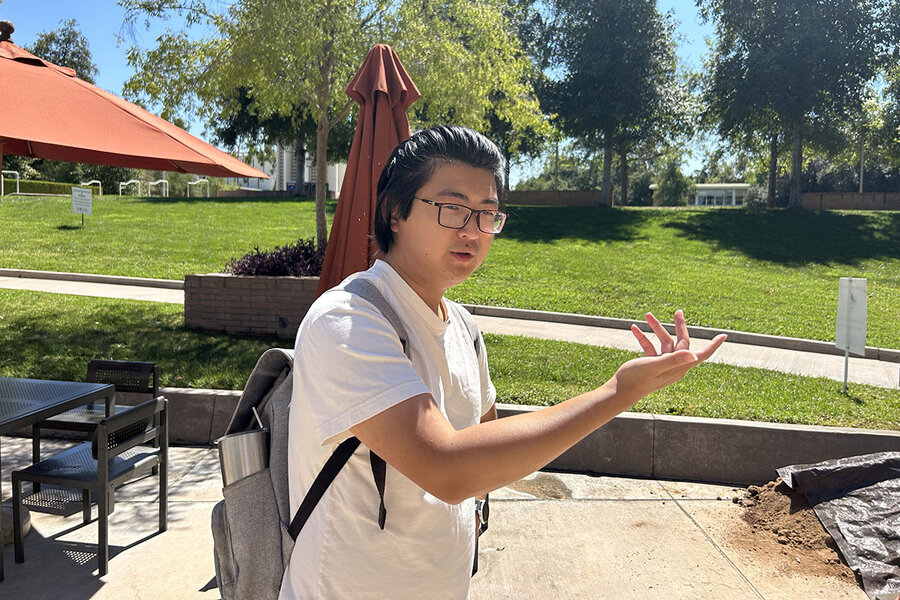No room in the dorm? California students get creative with housing.
Loading...
| Riverside, Calif.
Le’Ana Jackson, a senior at the University of California, Riverside, is ambivalent about campus housing.
Her junior year, the school didn’t tell her until a month before classes started that she and her roommate could share a $1,750-a-month, one-bedroom apartment. They couldn’t sign their lease until the second week in October, so she had to pay to stay in a hotel.
Why We Wrote This
Soaring rents and overcrowded dorms are making housing a priority on many U.S. campuses. How is one state trying to ease the burden and help students feel more at home?
“My parents were mad. They were like, ‘Just switch schools. Come home to Sacramento State.’ But I waited out the two weeks,” says Ms. Jackson.
A range of situations face students in one of California’s three higher education systems. Some people have lived in vehicles or commuted long distances from home. Schools have pushed dorm capacities. Housing costs and rents skyrocketed post-pandemic.
California is a snapshot of how this problem has played out for students across the United States. Frustration with campuses up and down the state is common going into another school year.
“We need to continue to be able to expand our housing,” says Gerry Bomotti, a vice chancellor at UC Riverside, “but at the same time, be conscious of and provide [a wide variety of] cost options for people ... so that they can afford to come here and get their education.”
Le’Ana Jackson doesn’t hide her ambivalence toward the University of California, Riverside, office of campus housing. Questionable experiences during her sophomore and junior years forced her to be more proactive as a senior.
She applied for campus housing this past March – and never heard back from the school. So she and two friends have joined with three other female students that they don’t know to split a six-bedroom house near campus.
“UCR has a record for awarding more housing to students than they can house,” says Ms. Jackson, a political science major.
Why We Wrote This
Soaring rents and overcrowded dorms are making housing a priority on many U.S. campuses. How is one state trying to ease the burden and help students feel more at home?
Although that school is the focal point of Ms. Jackson’s woes, a report found there were as many as 417,000 California college students who didn’t have stable housing in the state’s three higher education systems: the University of California, California State University, and California Community Colleges. Some students have lived in vehicles or commuted long distances from home – a few via plane. Schools have pushed dorm capacities to limits, where units that used to house two students now house three. The problem is two-sided, involving a lack of inventory for students to rent and affordability. Housing costs and rents here have skyrocketed post-pandemic, as they have elsewhere in the United States.
California is a snapshot of how this problem has played out for students across the country. According to a report released in 2021 by The Hope Center for College, Community, and Justice, 43% of university students and 52% of community college students indicated in fall 2020 that they were experiencing housing insecurity. Students also reported having higher rates of anxiety and depression, lower GPAs, and worse health.
In California, the reality of near-homelessness is sometimes bleak, and frustration with campuses up and down the state is common going into another school year.
“We need to continue to be able to expand our housing, but at the same time, be conscious of and provide [a wide variety of] cost options for people ... so that they can afford to come here and get their education,” says Gerry Bomotti, vice chancellor of planning, budget, and administration at the University of California, Riverside.
Mr. Bomotti says that unlike coastal California schools, UC Riverside had many private housing units available to students at a reasonable price pre-COVID. Post-pandemic, 32,000 units were filled by people leaving more expensive coastal areas for what is known as the Inland Empire, exacerbating the housing problem where UC Riverside is located. Additionally, the UC system let students in campus housing out of leases during spring 2020 when the pandemic hit and didn’t require them to pay penalties or remaining balances, says Mr. Bomotti.
“The housing in general in the private housing market did not offer that option, and in general they held students to their leases. So I think a lot of students – not all, but many of them – learned from that and were like, ‘Hey, I’m better off if I get housing at the university,’” Mr. Bomotti speculates.
Many California schools across the three systems serve first-generation and low-income students. First-year students are given priority to stay on campus, which officials say helps retention and graduation rates by fostering a stronger connection to the school. Graduate students, many of whom already have their own families, need housing, too, as do community college students.
The state steps in
California Gov. Gavin Newsom, a Democrat, and other state leaders pledged more than $2 billion to build housing on 35 campuses over two years starting in 2022. In 2022, $1.4 billion was given to start construction on more than a dozen of those campuses, followed by $750 million for 2023. More than $1 billion was initially pledged for community colleges to build dorms, but that money was yanked from the budget due to California’s deficit.
State lawmakers also pledged $1.8 billion in interest-free loans for schools to build. More than 20,000 new low-cost housing units for students are planned, with some already starting construction. California has also provided tens of millions of dollars for initiatives such as free public transportation for students, depending on the geographic locations of their campuses.
At UC Riverside, where the school has added 2,326 beds since 2019 and plans to add 1,568 more on its north campus, the state just awarded $126 million for a project. The school will designate 652 of those beds for Riverside Community College District students. The hope is that the new building will open in fall 2025, Mr. Bomotti says. It is the second of a four- or five-phase housing build for their north district, which will add thousands more beds to the 8,700 the school currently has.
That will go a long way toward addressing the more than 3,300 students on the campus waiting list, Mr. Bomotti says.
“We do have the capacity to increase our enrollment, and we want to in order to serve California students,” he says. “So housing, and availability and affordability, is very key and critical for us.”
Delayed leases, flying to campus
Ms. Jackson, at UC Riverside, started college during the pandemic, which meant she stayed home in Sacramento her freshman year. Sophomore year, she was placed in an off-campus studio apartment through the university for a little under $700 a month. Junior year, UC Riverside didn’t tell her and her roommate until a month before classes started that they could share a $1,750-a-month, one-bedroom apartment a long walk from campus. School started at the end of September, but they couldn’t sign their lease until the second week in October. She had to pay for a hotel in the meantime.
“My parents were mad. They were like, ‘Just switch schools. Come home to Sacramento State.’ But I waited out the two weeks,” says Ms. Jackson, who described the process as long and dreary.
One of the more arresting news stories to surface about the housing shortage was a graduate student from UC Berkeley who flew from Los Angeles, where he lived, to Berkeley, where he took classes three days a week. Cost was the reason he cited.
Graduate students, who already have fewer beds available, also have felt the effects of the crunch. Rafael Jaime is a Ph.D. candidate at the University of California, Los Angeles and president of UAW 2865, a union representing more than 36,000 graduate student instructors, researchers, and teaching assistants. He led the largest strike in U.S. higher education in 2022 that resulted in significant raises for teaching assistants, about a 50% increase in base pay by the end of 2024. That helps to pay for exorbitant rent, which had been taking up to a whopping 55% of their pay. Housing wasn’t specifically addressed in the contract, but in the next one it should be, he says.
“This makes it really difficult for the University of California to attract the best talent, but it also makes it really difficult for those who are here to actually be able to do the kind of research and teaching that we’re here to do. And a lot of us, there are many who have been forced out because of the cost of living crisis,” Mr. Jaime says.
He thinks government intervention is needed. A combination of not just students, but workers for schools and residents unaffiliated with universities are driving prices up, he says.
Mr. Jaime travels at least 45 minutes by subway from his downtown LA studio apartment, to the Westwood area where UCLA is, several times a week.
At UC Riverside, Issac Lin is getting a Ph.D. in physics. He is in the second year of his program and had to find housing while still in China, his country of origin. He found a roommate through his Ph.D. program. They each pay a little less than $1,100 per month for a two-bedroom apartment in Moreno Valley, a neighboring town to Riverside, which he commutes to by bus.
Rent ate through a lot of his teaching assistant salary that first year, he says. The raise he got after the strike has helped with housing costs.
“I tried to get campus housing, but I quickly realized that that wasn’t going to happen,” Mr. Lin says while walking across the sleepy campus recently. “They said something about a waiting list, but it was too long,” he says, shaking his head.









